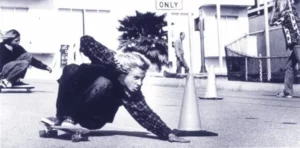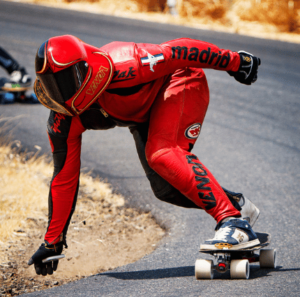Downhill longboarding has always had an edge. Born from the original street spirit of skateboarding, it has roots in rebellion, counterculture, and the pursuit of raw speed. While it started as an underground thrill and a side piece to regular skating, downhill longboarding has evolved into a structured, competitive sport with official races, sponsors, and a seriously devoted global community. But how did this transformation happen? And where is the sport headed next? Let’s take a look at the past, present, and future of downhill longboarding.

Origins: Surfing the Streets
Downhill longboarding, like traditional skateboarding, owes its origins to surfers in the 1950s and ‘60s. When the waves were flat, surfers took to the streets on makeshift boards, adapting their balance and carving skills to asphalt. This early form of longboarding was more about cruising than speed, but as boards evolved, so did the riders’ ambitions and eventually there was this sort of split into the more conventional styles of street and ramp/park (vert and transition aka tranny) skating that we see today, and the subculture of downhill.
The 1970s saw the first inklings of downhill as a serious pursuit. With the rise of urethane wheels – a breakthrough for better grip and control than the original clay wheels – riders started bombing hills with more confidence. Skateboarders in Southern California, particularly in places like La Costa and Signal Hill, began organizing the first proper downhill races. The fastest rider to the bottom won – no complicated rules, no major sponsors, just pure speed and adrenaline.
The 1980s and ‘90s: The Underground Years
By the 1980s, skateboarding culture was shifting toward street skating and vert, thanks to legends like Tony Hawk and Mark “The Gonz” Gonzales. Downhill longboarding didn’t disappear, but it remained a niche within the broader skate world that was quickly becoming commercialized and slowly taken up by the mainstream. Those who loved speed kept pushing boundaries, but without much industry support, downhill was more of an underground movement than an organized sport.
During the 1990s, however, things began to change. Innovations in board design – longer decks, precision trucks, and better wheel formulas – allowed for greater control at higher speeds. Riders started experimenting with slides, tuck positions, and more aggressive turning techniques, making downhill more than just an all-out speed race. It became a discipline of its own, demanding technical skill and control.
This time period also saw the emergence of small-scale competitions. Riders gathered to test their speed and skill on closed roads, often setting up hay bales as makeshift crash barriers. It was still far from mainstream, but the culture was growing.

The 2000s: The Rise of a Legitimized Sport
The early 2000s marked a turning point for downhill longboarding. The internet played a massive role, allowing riders from around the world to share videos, techniques, and race footage. Suddenly, what was once a fragmented underground scene became a connected global community.
During this time, organizations like the International Gravity Sports Association (IGSA) began formalizing downhill racing. Official events with structured rules, safety requirements, and rankings provided legitimacy to the sport. Events like Maryhill Festival of Speed, Newton’s Nation, and the Kozakov Challenge attracted international talent and media attention.
Technological advancements also fueled the sport’s growth. Boards became more specialized, with carbon fiber decks, precision trucks, and high-performance wheels allowing for even greater speeds. Riders started breaking the 60 mph barrier, and techniques like pre-drifting into turns and advanced tucking styles became standard.
This period also saw an explosion in media coverage. YouTube, Instagram, and Vimeo became platforms for riders to showcase their skills. Viral videos of high-speed bombing mountain roads introduced downhill longboarding to millions, inspiring a new generation of riders.
The 2010s: Peak Popularity and Challenges
By the 2010s, downhill longboarding had reached its peak popularity. Major brands entered the scene, sponsoring riders and pushing product innovations. Events became bigger and better funded, with live streams and professional-grade media coverage.
However, with growth came challenges. Safety concerns became a major issue as more riders attempted to push their limits on open roads, leading to injuries and fatalities. Some communities started cracking down on downhill riding, enforcing strict laws against bombing hills on public streets.
At the same time, the sport faced a shift in culture. The industry that once thrived on core riders and DIY spirit began commercializing. While this brought more opportunities for pros, it also led to debates about whether downhill was losing its underground roots.
Today’s State of Downhill Longboarding
As of the 2020s, downhill longboarding exists in a unique space. It’s no longer the booming phenomenon it was in the early 2010s, but it remains a dedicated and passionate community. New racing circuits, such as the International Downhill Federation (IDF), continue to host events, while grassroots racing is still thriving in local scenes worldwide.
Technology continues to evolve. Aerodynamic gear, advanced board materials, and even electronic stability features are being explored to push the limits further. Simultaneously, there’s been a resurgence of the DIY spirit, with many riders building their own gear, organizing unofficial races, and bringing downhill back to its rebellious roots.
One of the biggest ongoing debates is whether downhill longboarding should be considered for Olympic inclusion. While some argue that its mix of skill, speed, and danger makes it a perfect extreme sport for global competition, others believe its counterculture identity should remain separate from mainstream sports institutions.
The Future: Where is Downhill Longboarding Headed?
The future of downhill longboarding will likely be shaped by a balance between sport and culture. Here are some potential directions:
- Safer Racing Environments – More closed-road events to reduce injuries and legal issues.
- Tech Innovations – Further advancements in aerodynamics and board materials.
- Media Expansion – More professional-grade videos and documentaries could bring new audiences.
- Olympic Recognition – Will downhill longboarding ever make it to the biggest stage in sports?
- Resurgence of DIY Culture – With large brands moving on, grassroots communities may take control once again.
Closing Thoughts: A Sport with a Soul
Downhill longboarding is more than just a sport – it’s a movement, a lifestyle, and a testament to human daring, similar to its roots in conventional skateboarding and, before that, surfing. From its humble ocean-inspired beginnings to high-speed international competitions, it has come a long way. While it may never be as mainstream as street or vert skateboarding, its dedicated community ensures that the spirit of bombing hills and carving lines will never die.
No matter where the sport heads next, one thing is certain: as long as there are riders willing to point their boards downhill, the evolution of longboarding will continue.







